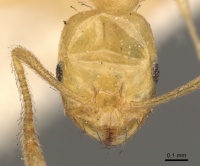Monomorium pallidum
| Monomorium pallidum | |
|---|---|

| |
| Scientific classification | |
| Kingdom: | Animalia |
| Phylum: | Arthropoda |
| Class: | Insecta |
| Order: | Hymenoptera |
| Family: | Formicidae |
| Subfamily: | Myrmicinae |
| Tribe: | Solenopsidini |
| Genus: | Monomorium |
| Species: | M. pallidum |
| Binomial name | |
| Monomorium pallidum Donisthorpe, 1918 | |
Identification
Distribution
Latitudinal Distribution Pattern
Latitudinal Range: 27.033333° to 27.033333°.
| North Temperate |
North Subtropical |
Tropical | South Subtropical |
South Temperate |
- Source: AntMaps
Distribution based on Regional Taxon Lists
Palaearctic Region: Afghanistan, Iraq (type locality), Iran, Israel.
Distribution based on AntMaps
Distribution based on AntWeb specimens
Check data from AntWeb
Countries Occupied
| Number of countries occupied by this species based on AntWiki Regional Taxon Lists. In general, fewer countries occupied indicates a narrower range, while more countries indicates a more widespread species. |

|
Estimated Abundance
| Relative abundance based on number of AntMaps records per species (this species within the purple bar). Fewer records (to the left) indicates a less abundant/encountered species while more records (to the right) indicates more abundant/encountered species. |

|
Biology
Castes
Nomenclature
The following information is derived from Barry Bolton's Online Catalogue of the Ants of the World.
- pallidum. Monomorium (Parholcomyrmex) destructor var. pallidus Donisthorpe, 1918b: 166 (w.) IRAQ.
- Type-material: lectotype worker (by designation of Borowiec, L., Mossadegh, et al. 2019: 3); ca 90 paralectotype workers.
- Type-locality: lectotype Iraq (“Mesopotamia”): Amara, on Tigris River, 10.ii.1918 (W.E. Evans); paralectotypes with same data.
- Type-depository: BMNH.
- Crawley, 1920b: 179 (q.).
- Combination in Monomorium confirmed: Borowiec, L., Mossadegh, et al. 2019: 3.
- Subspecies of destructor: Emery, 1922e: 180; Bernard, 1948: 144; Ettershank, 1966: 91; Kugler, J. 1988: 258; Bolton, 1995b: 265.
- Status as species: Crawley, 1920b: 178 (redescription); Vonshak, et al. 2009: 43; Borowiec, L. 2014: 123; Borowiec, L., Mossadegh, et al. 2019: 3 (redescription).
- Distribution: Iran, Iraq, Israel.
Type Material
- Lectotype (designated by Borowiec et al., 2019: 3), worker, Amara, "Mesopotamia", Iraq, Evans, B.M. 1934-4; BMNHE 1015255; ANTWEB CASENT0902219, The Natural History Museum.
- Paralectotype (designated by Borowiec et al., 2019: 3), workers, Amara, "Mesopotamia", Iraq, Evans, B.M. 1934-4; BMNHE 1015255; ANTWEB CASENT0902219, The Natural History Museum.
Description
References
- Borowiec L, 2014. Catalogue of ants of Europe, the Mediterranean Basin and adjacent regions (Hymenoptera: Formicidae). Genus (Wroclaw) 25 (1–2): 1 – 340.
- Borowiec, L. 2014. Catalogue of ants of Europe, the Mediterranean Basin and adjacent regions (Hymenoptera: Formicidae). Genus (Wroclaw) 25(1-2): 1-340.
- Borowiec, L., Mossadegh, M.S., Salata, S., Mohammadi, S., Torfi, E.T., Toosi, M., Almasi, A. 2019. Redescription of Monomorium pallidum Donisthorpe, 1918, revised status. Asian Myrmecology 11: e011001.
- Crawley, W. C. 1920b. Ants from Mesopotamia and north-west Persia (concluded). Entomol. Rec. J. Var. 32: 177-179 (page 178, queen described)
- Donisthorpe, H. 1918c. A list of ants from Mesopotamia; with a description of a new species and a new variety. Entomol. Rec. J. Var. 30: 165-167 (page 166, worker described)
- Pisarski B, 1967. Ameisen (Formicidae) von Dr. J. Klapperich in Afghanistan gesammelt. Polskie Pismo Entomologiczne 37: 47 – 51.
References based on Global Ant Biodiversity Informatics
- Borowiec L. 2014. Catalogue of ants of Europe, the Mediterranean Basin and adjacent regions (Hymenoptera: Formicidae). Genus (Wroclaw) 25(1-2): 1-340.
- Borowiec L., M. S. Mossadegh, S. Salata, S. Mohammadi, E. T. Torfi, M. Toosi, and A. Almasi. 2019. Redescription of Monomorium pallidum Donisthorpe, 1918, revised status. Asian Myrmecology 11, e011001.
- Crawley W. C. 1920. Ants from Mesopotamia and north-west Persia (concluded). Entomol. Rec. J. Var. 32: 177-179.
- Donisthorpe H. 1918. A list of ants from Mesopotamia; with a description of a new species and a new variety. Entomologist's Record and Journal of Variation 30: 165-167.
- Izhaki I., B. Idelovich, R. Laster, and Y. Ofer. 2009. The impact of macro- vs micro environmental factors on the structure of ant communities inhabiting East-Mediterranean Aleppo pine forests. Israel Journal of Entomology 39: 129-146.
- Pisarski B. 1964. Fauna Mrowek Afganistanu. Bibliogr. k. 160-166, Nieoprawiony maszynopis pracy, Praca doktorska. Instytut Zoologiczny PAN, 1964, Bibliogr. p. 160-166
- Vonshak M., and A. Ionescu-Hirsch. 2009. A checklist of the ants of Israel (Hymenoptera: Formicidae). Israel Journal of Entomology 39: 33-55.

